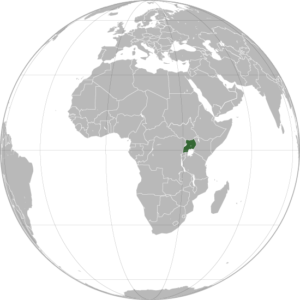Uganda
Uganda is a country in East Africa known for its rich biodiversity, dynamic culture, and emerging natural resource sector.
 Uganda is strategically located in the heart of East Africa. It is a landlocked nation bordered by South Sudan to the north, Kenya to the east, Tanzania to the south, Rwanda to the southwest, and the Democratic Republic of the Congo to the west. Covering an area of approximately 241,000 km², Uganda boasts diverse landscapes ranging from fertile highlands and vast savannahs to the shores of Lake Victoria, one of the largest freshwater lakes in the world. With an estimated population of around 46 million people in 2024, Uganda is characterized by its youthful and rapidly growing demographic. Kampala, the capital and largest city, serves as the nation’s political, economic, and cultural hub.
Uganda is strategically located in the heart of East Africa. It is a landlocked nation bordered by South Sudan to the north, Kenya to the east, Tanzania to the south, Rwanda to the southwest, and the Democratic Republic of the Congo to the west. Covering an area of approximately 241,000 km², Uganda boasts diverse landscapes ranging from fertile highlands and vast savannahs to the shores of Lake Victoria, one of the largest freshwater lakes in the world. With an estimated population of around 46 million people in 2024, Uganda is characterized by its youthful and rapidly growing demographic. Kampala, the capital and largest city, serves as the nation’s political, economic, and cultural hub.
Economy and Mining Potential
Uganda’s economy has traditionally been based on agriculture, but in recent years, the nation has begun to diversify into sectors such as services, tourism, and mining. While still in its developmental stage, the mining sector is gradually emerging as a significant contributor to economic growth. Uganda is endowed with a variety of mineral resources, including gold, tin, tungsten, and industrial minerals like limestone. Recent exploration activities have also revealed potential deposits of copper and cobalt. These resources offer promising opportunities for both domestic development and international investment, especially as the government implements reforms to enhance the mining sector’s attractiveness.
Geography and Natural Resources
Uganda’s varied geography provides the foundation for its wealth of natural resources. The country’s landscapes range from the lush, green highlands and expansive savannahs to the aquatic environments surrounding Lake Victoria. This environmental diversity conceals significant mineral deposits that are gradually being recognized as vital for economic diversification.
Key mineral resources include:
- Gold: An emerging focus area with exploration and small-scale mining operations.
- Tin and Tungsten: Minerals that contribute to Uganda’s growing mining portfolio.
- Limestone: Essential for construction and industrial processes.
- Potential Deposits: Ongoing exploration for copper, cobalt, and other critical minerals.
Mining Sector Development
The Ugandan government has embarked on reforms to modernize the mining sector by streamlining licensing procedures, improving regulatory frameworks, and investing in infrastructure. These measures aim to attract both local and foreign investors. Notable projects in the early stages of development, particularly in gold mining, signal Uganda’s commitment to harnessing its mineral wealth responsibly and sustainably.
Mining-Related Characteristics
- Rich Natural Resources:
Uganda’s mineral portfolio is diverse, with significant deposits that promise to fuel economic growth and industrial development. - Emerging Technological Adoption:
Mining companies in Uganda are beginning to integrate advanced technologies such as remote sensing, geospatial mapping, and automated systems to optimize extraction processes and enhance safety. - Community and Environmental Focus:
With growing awareness of environmental and social responsibilities, stakeholders are working to ensure that mining operations contribute positively to local communities while minimizing ecological impact.
Challenges in Uganda
Despite its promising potential, Uganda faces challenges in fully realizing its mining sector’s capabilities. Key obstacles include:
- Infrastructure Gaps: Limited transportation, energy, and logistical networks can hinder efficient mining operations.
- Regulatory and Policy Barriers: Continued efforts are needed to refine regulations and foster a transparent, investor-friendly environment.
- Environmental Concerns: Mitigating the ecological impact of mining activities remains a priority, necessitating sustainable practices and community engagement.
Historical and Political Development
Uganda gained independence from British colonial rule in 1962 and has since navigated a complex political landscape marked by periods of turmoil and reform. Today, Uganda is a republic with a government committed to fostering stability, economic reform, and sustainable development. The country’s evolving political environment continues to support initiatives aimed at diversifying its economy and tapping into its mineral potential.
Geography, Climate, and Demographics
Uganda’s physical geography is as diverse as its culture, featuring fertile highlands, rolling savannahs, and extensive water systems. The climate is predominantly tropical, tempered by altitude in many regions, which supports a wide range of agricultural and economic activities. Ethnically and linguistically diverse, Uganda’s vibrant society is characterized by a mix of traditional practices and modern influences, all contributing to its dynamic national identity.
In summary, Uganda is an emerging East African nation with a wealth of natural resources and a growing mining sector. As the government and private sector work together to overcome infrastructural and regulatory challenges, Uganda’s mining industry is poised to become a key pillar of economic development, offering abundant opportunities for sustainable growth and investment.

